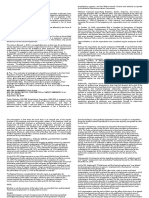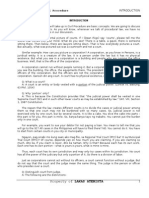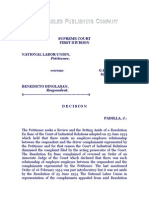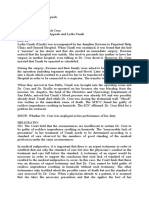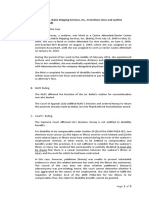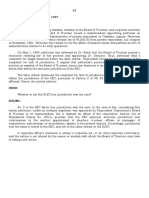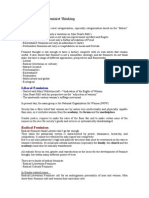RAMOS Vs CA
RAMOS Vs CA
Uploaded by
Win SanchoCopyright:
Available Formats
RAMOS Vs CA
RAMOS Vs CA
Uploaded by
Win SanchoOriginal Description:
Original Title
Copyright
Available Formats
Share this document
Did you find this document useful?
Is this content inappropriate?
Copyright:
Available Formats
RAMOS Vs CA
RAMOS Vs CA
Uploaded by
Win SanchoCopyright:
Available Formats
RAMOS vs.
CA Case Digest
ROGELIO RAMOS and ERLINDA RAMOS vs. CA 380 SCRA 467 Facts: Petitioner Erlinda Ramos was advised to undergo an operation for the removal of her stone in the gall bladder. She was referred to Dr. Hosaka, a surgeon, who agreed to do the operation. The operation was scheduled on June 17, 1985 in the De los Santos Medical Center. Erlinda was admitted to the medical center the day before the operation. On the following day, she was ready for operation as early as 7:30 am. Around 9:30, Dr. Hosaka has not yet arrived. By 10 am, Rogelio wanted to pull out his wife from the operating room. Dr. Hosaka finally arrived at 12:10 pm more than 3 hours of the scheduled operation. Dr. Guiterres tried to intubate Erlinda. The nail beds of Erlinda were bluish discoloration in her left hand. At 3 pm, Erlinda was being wheeled to the Intensive care Unit and stayed there for a month. Since the illfated operation, Erlinda remained in comatose condition until she died. The family of Ramos sued them for damages. Issue: Whether or not there was an employee-employer relationship that existed between the medical center and Drs. Hosaka and Guiterrez. Ruling: Private Hospitals hire, fire and exercise real control over their attending and visiting consultant staff. While consultants are not technically employees, the control exercised, the hiring and the right to terminate consultants fulfill the hallmarks of an employer-employee relationship with the exception of payment of wages. The control test is determining. In applying the four fold test, DLSMC cannot be considered an employer of the respondent doctors. It has been consistently held that in determining whether an employer-employee relationship exists between the parties, the following elements must be present: (1) selection and engagement of services; (2) payment of wages; (3) the power to hire and fire; and (4) the power to control not only the end to be achieved, but the means to be used in reaching such an end. The hospital does not hire consultants but it accredits and grants him the privilege of maintaining a clinic and/or admitting patients. It is the patient who pays the consultants. The hospital cannot dismiss the consultant but he may lose his privileges granted by the hospital. The hospitals obligation is limited to providing the patient with the preferred room accommodation and other things that will ensure that the doctors orders are carried out. The court finds that there is no employer-employee relationship between the doctors and the hospital.
You might also like
- Family Law Class Notes & CasesDocument14 pagesFamily Law Class Notes & CasesSummer97% (35)
- Nogales Vs CMCDocument2 pagesNogales Vs CMCmyles15No ratings yet
- St. Paul College Quezon City, Et. Al v. Remigio Michael A. Ancheta II and Cynthia A. AnchetaDocument16 pagesSt. Paul College Quezon City, Et. Al v. Remigio Michael A. Ancheta II and Cynthia A. Anchetajirah cheeNo ratings yet
- 3 Divorce in The Kibbutz Add LiisaDocument2 pages3 Divorce in The Kibbutz Add LiisaSalman HassanNo ratings yet
- Bullying Research Proposal Madam DorieDocument5 pagesBullying Research Proposal Madam DorieAnonymous 09qY9Wpj8No ratings yet
- Netherlands Visa Guidelines - Verision 1.8Document14 pagesNetherlands Visa Guidelines - Verision 1.8Yashpal Singh100% (1)
- Ramos vs. CADocument29 pagesRamos vs. CAPanday L. Mason100% (2)
- 001 Ramos VS CaDocument1 page001 Ramos VS CaMelgenNo ratings yet
- Professional Services Inc vs. Natividad AganaDocument5 pagesProfessional Services Inc vs. Natividad AganaianNo ratings yet
- Rosit Vs Davao Doctors Hospital (2015) - GEN - Expert Witness Is Necessary To Establish Negligence. XPN - If Res Ipsa Loquitour Is ApplicableDocument3 pagesRosit Vs Davao Doctors Hospital (2015) - GEN - Expert Witness Is Necessary To Establish Negligence. XPN - If Res Ipsa Loquitour Is ApplicableHiroshi Carlos100% (1)
- Crim 2 #02 Dr. Jarcia, Jr. and Dr. Bastan Vs People, GR No. 187926 Reckless Imprudence ArtajoDocument13 pagesCrim 2 #02 Dr. Jarcia, Jr. and Dr. Bastan Vs People, GR No. 187926 Reckless Imprudence ArtajoAmy Lou Cabayao100% (1)
- GR No. 166869Document2 pagesGR No. 166869Calauagan DynaNo ratings yet
- Case Digest (Labor)Document17 pagesCase Digest (Labor)Adi DokgoNo ratings yet
- Herrera Vs Quezon City Board of Assessment Appeals: FactsDocument2 pagesHerrera Vs Quezon City Board of Assessment Appeals: FactsBryne Angelo BrillantesNo ratings yet
- Rogelio Nogales Vs Capitol Medical CenterDocument8 pagesRogelio Nogales Vs Capitol Medical CenterMaius GaerlanNo ratings yet
- Ramos Vs CA DigestDocument2 pagesRamos Vs CA Digestemi_lou100% (1)
- Quezon City Government v. DacaraDocument4 pagesQuezon City Government v. DacaraSiobhan RobinNo ratings yet
- Jarcia, Jr. vs. People of The Philippines, G.R. No. 187926Document14 pagesJarcia, Jr. vs. People of The Philippines, G.R. No. 187926Glydenne GayamNo ratings yet
- Chapter 3 Case Digest CompiledDocument42 pagesChapter 3 Case Digest CompiledHannaSalatanNo ratings yet
- People vs. Tan Boon Kong (1930)Document3 pagesPeople vs. Tan Boon Kong (1930)Mark De JesusNo ratings yet
- City of Manila, Genaro N. Teotico and Court of Appeals, G.R. No. L-23052, January 29, 1968 FactsDocument4 pagesCity of Manila, Genaro N. Teotico and Court of Appeals, G.R. No. L-23052, January 29, 1968 FactsOlinayag EllehcimNo ratings yet
- LABOR STANDARDS - Employment of AliensDocument2 pagesLABOR STANDARDS - Employment of Alienschisel_159No ratings yet
- G.R. No. 130003Document8 pagesG.R. No. 130003Kooking JubiloNo ratings yet
- 4 Casumpang V CortejoDocument2 pages4 Casumpang V CortejoAlleine TupazNo ratings yet
- Civ Pro Introduction InigoDocument7 pagesCiv Pro Introduction InigoMyrna ValledorNo ratings yet
- SJS vs. LimDocument150 pagesSJS vs. LimRuth LumibaoNo ratings yet
- Pci Vs NLRCDocument9 pagesPci Vs NLRCBryan Nartatez BautistaNo ratings yet
- Professional Services V AGana Lega MedDocument7 pagesProfessional Services V AGana Lega Medcha chaNo ratings yet
- Case Digest TopicsDocument3 pagesCase Digest TopicsAngelie Mae MacarilayNo ratings yet
- Dr. Noel Casumpang vs. Cortejo Digest Legal MedicineDocument14 pagesDr. Noel Casumpang vs. Cortejo Digest Legal MedicineKevin G. PerezNo ratings yet
- Herrera and Herrera v. Quezon City Board of Assessment Appeals, 3 SCRA 186 (1961)Document9 pagesHerrera and Herrera v. Quezon City Board of Assessment Appeals, 3 SCRA 186 (1961)Christiaan Castillo100% (1)
- Air France Vs Carrascoso ISSUE 2: Whether or Not The Testimony of Carrasoso RegardingDocument6 pagesAir France Vs Carrascoso ISSUE 2: Whether or Not The Testimony of Carrasoso RegardingJuan Carlo CastanedaNo ratings yet
- Reyes vs. Sisters of Mercy HospitalDocument24 pagesReyes vs. Sisters of Mercy HospitaloliveNo ratings yet
- 16 - Ramos vs. CA PDFDocument2 pages16 - Ramos vs. CA PDF123abc456def100% (1)
- 2) Algura vs. LGU of NagaDocument13 pages2) Algura vs. LGU of Nagadar080No ratings yet
- FEBTC v. Pacilan Digest: Callejo SR, J.Document9 pagesFEBTC v. Pacilan Digest: Callejo SR, J.Arcide Rcd ReynilNo ratings yet
- National Labor Union vs. Dinglasan, G.R. No. L-7945, March 23, 1956, 98 Phil. 649Document5 pagesNational Labor Union vs. Dinglasan, G.R. No. L-7945, March 23, 1956, 98 Phil. 649benbernNo ratings yet
- NOGALES V CMCDocument3 pagesNOGALES V CMC123abc456defNo ratings yet
- 3 Lucas v. TuañoDocument11 pages3 Lucas v. TuañoCases M7No ratings yet
- 2 Dr. Cruz v. CADocument2 pages2 Dr. Cruz v. CAMigs GayaresNo ratings yet
- RAMOS Vs HOSAKA CASEDocument3 pagesRAMOS Vs HOSAKA CASEMaius GaerlanNo ratings yet
- Atienza Vs Orophil GR. 191049Document1 pageAtienza Vs Orophil GR. 191049Crizedhen VardeleonNo ratings yet
- Manila Doctors Hospital v. So Un Chua Et AlDocument2 pagesManila Doctors Hospital v. So Un Chua Et AlFiona FedericoNo ratings yet
- Case Digest - GR 206758Document3 pagesCase Digest - GR 206758RewsEn100% (1)
- CD - 4. Dr. Victoria L. Batiquin and Allan Batiquin vs. Court of AppealsDocument2 pagesCD - 4. Dr. Victoria L. Batiquin and Allan Batiquin vs. Court of AppealsMykaNo ratings yet
- Doctrines in Legal MedicineDocument1 pageDoctrines in Legal MedicineJumen Gamaru TamayoNo ratings yet
- Discussion On Labor LawDocument5 pagesDiscussion On Labor Lawmichelle m. templadoNo ratings yet
- Escobin - v. - National - Labor - RelationsDocument21 pagesEscobin - v. - National - Labor - RelationsMonica FerilNo ratings yet
- Bernal Vs HouseDocument1 pageBernal Vs HouseDan Anthony BarrigaNo ratings yet
- #7 Tabang Vs NLRC G.R. No. 121143, January 21, 1997 FactsDocument1 page#7 Tabang Vs NLRC G.R. No. 121143, January 21, 1997 FactsPNP MayoyaoNo ratings yet
- A. Soriano Aviation v. Employees Association of A. Soriano AviationDocument15 pagesA. Soriano Aviation v. Employees Association of A. Soriano AviationAnnie Herrera-LimNo ratings yet
- 079-Jobel Enterprises and Lim v. NLRC G.R. No. 194031 August 8, 2011Document3 pages079-Jobel Enterprises and Lim v. NLRC G.R. No. 194031 August 8, 2011Jopan SJNo ratings yet
- Professional Services Vs AganaDocument3 pagesProfessional Services Vs AganaMaria Raisa Helga Ysaac100% (2)
- 006 Javier Vs Fly Ace CorpDocument2 pages006 Javier Vs Fly Ace CorpSamantha Ann T. TirthdasNo ratings yet
- Manila Doctors Hospital vs. So Un Chua and Vicky TyDocument1 pageManila Doctors Hospital vs. So Un Chua and Vicky TyMarcusNo ratings yet
- 2 Tropica HutDocument3 pages2 Tropica HutMary LouiseNo ratings yet
- Self Defense (Beninsig Vs People)Document3 pagesSelf Defense (Beninsig Vs People)FaithMayfairNo ratings yet
- Medical JurisprudenceDocument2 pagesMedical JurisprudenceGaebrelle BoiserNo ratings yet
- Elements of Quasi-DelictDocument20 pagesElements of Quasi-DelictJillian AsdalaNo ratings yet
- Random Bar Questions Labor LawDocument2 pagesRandom Bar Questions Labor LawVincent AbrugarNo ratings yet
- Torts and Damages: San Beda College of LawDocument32 pagesTorts and Damages: San Beda College of LawDrew MGNo ratings yet
- Ramos VS CaDocument1 pageRamos VS CaJillian AsdalaNo ratings yet
- RAMOS vs. CA Case DigestDocument1 pageRAMOS vs. CA Case DigestkeithnavaltaNo ratings yet
- Ramos Vs CADocument2 pagesRamos Vs CAAshley CandiceNo ratings yet
- Birks V PSEM GR No. 194307Document18 pagesBirks V PSEM GR No. 194307Win Sancho0% (1)
- Chapter I Income TaxesDocument48 pagesChapter I Income TaxesLovely Alyssa BonifacioNo ratings yet
- Cases Under Nationality of CorporationsDocument94 pagesCases Under Nationality of CorporationsWin SanchoNo ratings yet
- Criminal Procedure ReviewerDocument40 pagesCriminal Procedure ReviewerWin Sancho100% (4)
- Lanier V People of The Philippines DIGESTDocument1 pageLanier V People of The Philippines DIGESTWin Sancho100% (1)
- Credit Trans Related LawsDocument17 pagesCredit Trans Related LawsWin SanchoNo ratings yet
- Manila Motors Co V FloresDocument1 pageManila Motors Co V FloresWin SanchoNo ratings yet
- Searches & Seizures CasesDocument16 pagesSearches & Seizures CasesWin SanchoNo ratings yet
- Snackers - Nacho Snack PricelistDocument1 pageSnackers - Nacho Snack PricelistWin SanchoNo ratings yet
- Issue:: 3 Ofws From Davao Region Face Illegal Drug Trafficking AbroadDocument3 pagesIssue:: 3 Ofws From Davao Region Face Illegal Drug Trafficking AbroadWin SanchoNo ratings yet
- Attention Deficit Hyperactivity DisorderDocument17 pagesAttention Deficit Hyperactivity DisorderWin SanchoNo ratings yet
- Habit 7 - Seven Habits of Highly Effective PeopleDocument34 pagesHabit 7 - Seven Habits of Highly Effective PeopleWin SanchoNo ratings yet
- Positive Approach To Child Discipline - HelenDocument78 pagesPositive Approach To Child Discipline - HelenIan Khay Castro100% (1)
- Resettlement in China: Policy, Practice and Experiences: SHI Guoqing, ProfessorDocument81 pagesResettlement in China: Policy, Practice and Experiences: SHI Guoqing, Professorbhoj raj singalNo ratings yet
- The Diversity of Feminist ThinkingDocument4 pagesThe Diversity of Feminist ThinkingJuan Pablo DelgadoNo ratings yet
- Subclass - 600 Online Application Checklist Philippines: Visitor Visa - Tourist StreamDocument2 pagesSubclass - 600 Online Application Checklist Philippines: Visitor Visa - Tourist StreamStephanie Ann LopezNo ratings yet
- Conversation Questions AdoptionDocument7 pagesConversation Questions AdoptionRafaela Sepulveda LimaNo ratings yet
- UntitledDocument2 pagesUntitledapi-236961637No ratings yet
- Moot Problem VLC 2020Document4 pagesMoot Problem VLC 2020Prince bhaiNo ratings yet
- Sociology Cheat SheetDocument6 pagesSociology Cheat SheetShahmir AliNo ratings yet
- Agapao News June 06Document3 pagesAgapao News June 06Agapao InternationalNo ratings yet
- Book Review - Legs Get Led Astray - Bitch! MagazineDocument1 pageBook Review - Legs Get Led Astray - Bitch! MagazinemoswaksNo ratings yet
- What Is CounselingDocument26 pagesWhat Is Counselingguptamegha100% (1)
- The New African DiasporaDocument545 pagesThe New African DiasporaRodrigo P. BernardiNo ratings yet
- Bibi Halder NewDocument5 pagesBibi Halder NewRia BasuNo ratings yet
- DR - Ram Manohar Lohiya National Law University: Submitted To Submitted byDocument11 pagesDR - Ram Manohar Lohiya National Law University: Submitted To Submitted byAniket SachanNo ratings yet
- Case Report, Officer: Smith - j1, Supervisor: Cityofelgin/vanmastrigt - C, Merged By: Cityofelgin/lawrence - JDocument5 pagesCase Report, Officer: Smith - j1, Supervisor: Cityofelgin/vanmastrigt - C, Merged By: Cityofelgin/lawrence - JmikekvolpeNo ratings yet
- Underemployment - Definition, Causes, Effects, RateDocument5 pagesUnderemployment - Definition, Causes, Effects, RateNirmel RanjanendranNo ratings yet
- Unicef AssignmentDocument3 pagesUnicef AssignmentEzhil Vendhan PalanisamyNo ratings yet
- Reading Comprehension 4-Apridio Faiz A - 25 - ADocument2 pagesReading Comprehension 4-Apridio Faiz A - 25 - AApridio Faiz An NabilNo ratings yet
- The Journal of Negro History, Volume 1, January 1916 by VariousDocument301 pagesThe Journal of Negro History, Volume 1, January 1916 by VariousGutenberg.orgNo ratings yet
- Book Lovers Needed!: Volunteers Needed To Look For Rare Books, On Behalf of The Society of ST Vincent de Paul (SVP)Document4 pagesBook Lovers Needed!: Volunteers Needed To Look For Rare Books, On Behalf of The Society of ST Vincent de Paul (SVP)Dublin South Volunteer CentreNo ratings yet
- Strategic IntentDocument12 pagesStrategic Intentragvendra04No ratings yet
- (Nailbiting) (Secretive) (Cursing) (Overeating)Document4 pages(Nailbiting) (Secretive) (Cursing) (Overeating)Suzette Dalu-an CabarlesNo ratings yet
- Budapest Research Forum Releases Q1 Report On Local Office MarketDocument2 pagesBudapest Research Forum Releases Q1 Report On Local Office MarketallhungaryNo ratings yet
- The Guide To Getting A Divorce in India by Mutual ConsentDocument5 pagesThe Guide To Getting A Divorce in India by Mutual ConsentAbhishek Rakesh MisraNo ratings yet
- Template Invitation Letter To Sit On PanelDocument1 pageTemplate Invitation Letter To Sit On PanelJoderick Gomondan MontebonNo ratings yet
- Cruz vs. Cruz (October 11, 2017, G.R. No. 2019)Document13 pagesCruz vs. Cruz (October 11, 2017, G.R. No. 2019)Name ToomNo ratings yet


















